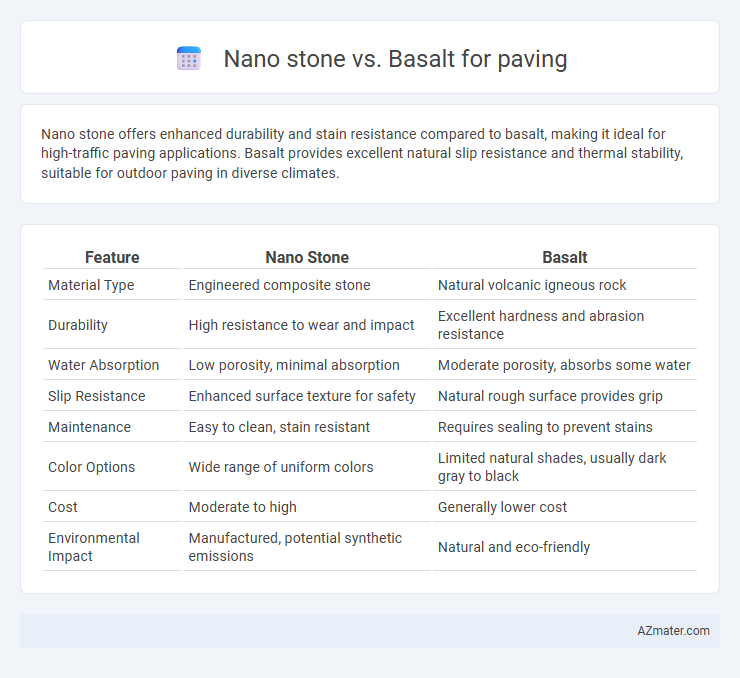Nano stone offers enhanced durability and stain resistance compared to basalt, making it ideal for high-traffic paving applications. Basalt provides excellent natural slip resistance and thermal stability, suitable for outdoor paving in diverse climates.
Table of Comparison
| Feature | Nano Stone | Basalt |
|---|---|---|
| Material Type | Engineered composite stone | Natural volcanic igneous rock |
| Durability | High resistance to wear and impact | Excellent hardness and abrasion resistance |
| Water Absorption | Low porosity, minimal absorption | Moderate porosity, absorbs some water |
| Slip Resistance | Enhanced surface texture for safety | Natural rough surface provides grip |
| Maintenance | Easy to clean, stain resistant | Requires sealing to prevent stains |
| Color Options | Wide range of uniform colors | Limited natural shades, usually dark gray to black |
| Cost | Moderate to high | Generally lower cost |
| Environmental Impact | Manufactured, potential synthetic emissions | Natural and eco-friendly |
Introduction to Nano Stone and Basalt Paving
Nano stone paving utilizes engineered nanomaterials to create highly durable, scratch-resistant surfaces with enhanced weather resistance, making it ideal for modern outdoor spaces. Basalt paving, derived from natural volcanic rock, offers exceptional strength, thermal stability, and slip resistance, commonly used in heavy-traffic areas and urban landscaping. Both materials provide sustainable, long-lasting solutions, with nano stone emphasizing innovative technology and basalt focusing on natural stone resilience.
Composition and Manufacturing Processes
Nano stone paving features a composite material primarily made from finely ground quartz, silica, and resin, engineered through a high-pressure molding process that enhances durability and resistance to wear. Basalt paving originates from natural volcanic rock, characterized by its dense, fine-grained composition, and is typically cut and polished from solid basalt slabs to maintain its inherent strength and thermal stability. The manufacturing of nano stone allows for uniformity and customization in texture and color, while basalt's natural formation provides exceptional hardness and weather resistance without the need for synthetic additives.
Surface Texture and Aesthetic Appeal
Nano stone offers a smooth, polished surface texture that enhances its aesthetic appeal with a sleek, modern look, ideal for contemporary paving designs. Basalt features a naturally rough and slightly porous texture, providing a rustic, earthy appearance that adds character and slip resistance to outdoor pathways. The choice between nano stone and basalt for paving hinges on the desired visual impact and tactile experience, balancing elegance with natural ruggedness.
Durability and Longevity Comparison
Nano stone offers exceptional durability with its enhanced surface hardness and resistance to wear, making it highly suitable for high-traffic paving applications. Basalt, known for its natural strength and weather resistance, provides long-lasting performance with excellent resistance to cracking and erosion over time. While both materials exhibit strong longevity, basalt's inherent density typically results in superior lifespan under harsh environmental conditions compared to nano stone.
Slip Resistance and Safety Features
Nano stone offers enhanced slip resistance due to its ultra-fine texture, making it ideal for wet or high-traffic areas where safety is a priority. Basalt, a natural volcanic rock, provides excellent durability and a naturally rough surface that reduces slip risk, especially in outdoor paving applications. Both materials contribute significantly to safety, but nano stone's engineered surface often outperforms basalt in controlled slip resistance tests.
Maintenance Requirements and Costs
Nano stone offers lower maintenance costs compared to basalt due to its enhanced durability and resistance to stains, minimizing the need for frequent cleaning and sealants. Basalt requires regular sealing and occasional repairs to prevent surface erosion and cracks, leading to higher long-term maintenance expenses. Choosing nano stone can reduce overall upkeep costs while maintaining a pristine appearance for paved surfaces.
Environmental Impact and Sustainability
Nano stone paving offers enhanced durability with minimal resource extraction due to its innovative manufacturing, significantly reducing environmental degradation and promoting sustainability. Basalt, a natural volcanic rock, boasts excellent longevity and low maintenance, making it an eco-friendly choice with a smaller carbon footprint over its lifecycle. Both materials contribute to sustainable paving solutions, but nano stone's engineered efficiency can lead to lower overall environmental impact in urban infrastructure projects.
Installation Techniques and Challenges
Nano stone paving requires precision in surface preparation due to its fine texture and uniform size, demanding a meticulously leveled base to prevent uneven settling. Basalt paving involves handling heavier, denser slabs that require specialized lifting equipment and careful alignment to avoid cracking during installation. Both materials necessitate expert jointing techniques to ensure durability, with nano stone favoring thin grout lines and basalt often using wider, flexible joints to accommodate natural expansion and contraction.
Cost Comparison: Nano Stone vs Basalt
Nano stone paving typically costs 20-30% less than basalt due to its engineered production process and lower material density. Basalt, a natural volcanic stone, commands higher prices because of quarrying, transportation, and durability advantages that extend its lifespan. Choosing nano stone offers budget-friendly installation without significant compromise on aesthetics, while basalt provides long-term value with higher initial investment.
Best Applications for Nano Stone and Basalt
Nano stone offers superior durability and low porosity, making it ideal for high-traffic urban paving, outdoor patios, and pool surrounds where slip resistance and weather resilience are critical. Basalt excels in heavy-duty applications such as industrial walkways, driveways, and public plazas due to its high compressive strength and natural thermal regulation properties. Both materials provide exceptional aesthetic appeal and longevity, with nano stone favored for modern design projects and basalt chosen for rugged, large-scale infrastructure.

Infographic: Nano stone vs Basalt for Paving
 azmater.com
azmater.com